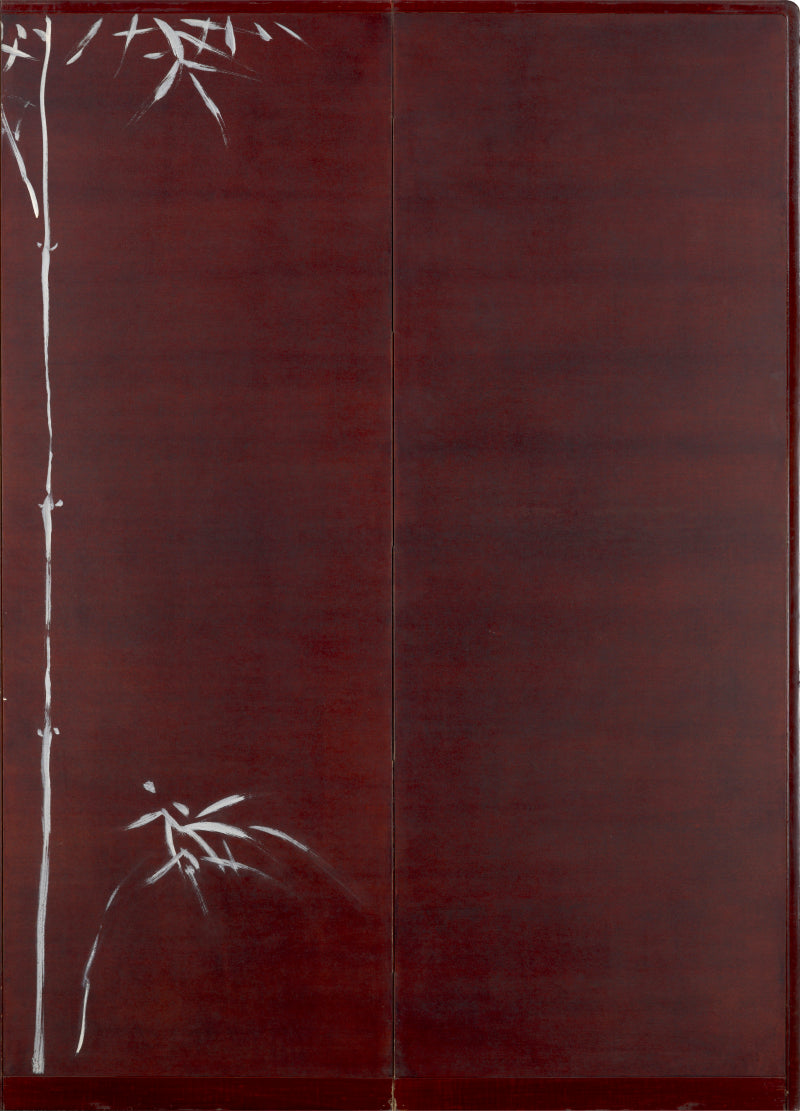Bamboo in Snow, Published 6 panel Screen Pair ー福田 古道人 "雪中竹圖, 六曲一双"
Bamboo in Snow, Published 6 panel Screen Pair ー福田 古道人 "雪中竹圖, 六曲一双"
Item Code: 古40
Since this product is an oversized item that requires custom shipping, please send us a message with the delivery address and we will come back to you with a shipping quote.
Contact form
A pair of rare Six Panel Screens opposing calligraphic verse with a bamboo stand in white on red by Fukuda Kodojin Published p. 230-231 No. 70 The Art and Life of Fukuda Kodojin (Minneapolis Institute of Art, 2023). Not only is a pair of screens by this artist rare, but this, depicted in white on paper dyed with Kakishibu Persimmon oil in a deep, burnt red color with a red frame, is unprecedented. Seen in dim light, the works appear almost as negative calligraphy, inscriptions of light on darkness—an apt metaphor for Kodojin’s vision of illumination within solitude. The right screen features verse like flowing clouds meandering through the red of sunset. The companion screen features bamboo rendered in luminous white brushstrokes, their straight, rhythmic forms rising through the deep red ground. The painting is accompanied by a brief poem: Where earlier Bunjinga painters sought atmospheric depth through ink modulation, Kodojin achieves spatial poetry through absence—the unpainted expanse of red ground functioning as both void and vitality. The technique evokes the Yohaku no bi (beauty of empty space) central to Zen-inflected aesthetics. Few works in Kodojin’s surviving corpus demonstrate such material daring. The juxtaposition of poem screen and image screen parallels the literati pairing of shi and hua—poetry and painting—embodying the ideal that “poetry is painting with words; painting is silent poetry.” Each screen measures 379 x 177 cm (149-1/4 x 69-1/2 inches) and both are in excellent original condition.
This work is POR. Please feel free to contact us.
Fukuda Kodojin (1865-1944) was an eccentric self-taught artist, his status as a poet, calligrapher and literati artist has reached legendary status. Born at a time of great change (4 years before the final fall of the Edo Government), he lived through the westernization of Meiji, Taisho Democracy, the rise of Imperialism and final defeat of the Showa eras. He was part of a small group of artists existing outside conventional circles in pre-war Japan. He moved to a village outside of Kyoto in 1901, where he supported himself and his family by privately tutoring those who wished to learn Chinese-style poetry. Kodojin was simply a scholar. His poetry, painting, and calligraphy all stem from a life-long cultivation of the mind. He was said to have taken the time just before his death to destroy the large portion of his own remaining work, leaving only that which must have met some personal criteria. Kodōjin’s paintings and calligraphy survive mainly in private collections, but significant works can be found in the collections of the British Museum, Freer Sackler Gallery of the Smithsonian Institute, Honolulu Museum of Art, Houston Museum of Fine Arts, Kumamoto Prefectural Museum of Art, Minneapolis Institute of Art, Museo Kaluz, New York Metropolitan Museum of Art, Portland Art Museum, Seattle Art Museum, St. Louis Art Museum, Tanabe City Museum of Art and Wakayama Prefectural Museum of Art among others including such well known Private collections as the Cowles Collection, Hakutakuan Collection, Manyoan Collection and Welch Collection. Twenty five paintings by the artist formed a private exhibition (from the Gitter-Yelen collection) at the New Orleans Museum of Art in 2000. In recent years, exhibitions such as The Last Master of the Literati Tradition: Fukuda Kodōjin (Minneapolis Institute of Art, 2023) have brought renewed attention to his achievement. For more on his life see the book Old Taoist, or Unexplored Avenues of Japanese Painting.
Share




























